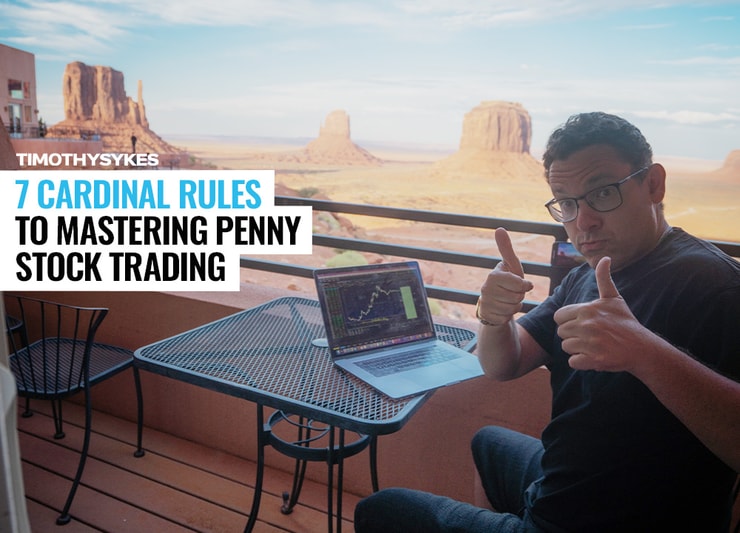Turning a small amount of money into millions from trading penny stocks isn’t impossible.
In fact, I’ve done it, and so have dozens of my students.
But that doesn’t mean it’s easy.
Most things that are worthwhile in life aren’t.
If you want to know what it takes to make it in this game…
I’ve broken it down into seven rules.
Table of Contents
Number #1: Don’t Chase…Plan Ahead

2025 Millionaire Media, LLCThe reason why I Iike penny stocks is because they’re cheap, follow predictable patterns, and are volatile.
For most investors, volatility is a scary word.
But if you’re an active trader you must learn to thrive off volatility.
The problem is, most newbie traders get excited when they see a stock up 20%,40%, or even 100% up in a day…they FOMO into the trade at the worst possible time and get wrecked.
Do I like fast movers?
You bet I do.
But the price has to be right.
That’s why I take a sniper approach when I’m trading.
I try to only take a shot when I have a clear aim.
For me, that usually waits for a panic dip buying opportunity.
You see, two traders can be in the same stock, but they can be in totally different trades dependent on the price they entered.
That’s why having a plan is so important.
Number #2: Knowledge Is Your Weapon
I’ve been in this game for +20 years…
I can trade from anywhere in the world and do so…
But you know what?
I still journal all my trades and review them.
Why?
Because the day you stop learning and trying to adapt to the market is when you regress.
Most newbies don’t realize how much time and dedication it takes to make it as a trader.
I have hundreds and hundreds of hours of teaching lessons recorded for my students.
If you ever decide to work with me, your number one job will be to STUDY…STUDY…STUDY.
There’s no shortcut. You either are willing to do the work, or you’re not.
More Breaking News
- Is Wolfspeed’s Downward Spiral Beyond Recovery?
- Metsera Inc. Booms: A Surge in Stock Value?
- Rhythm Pharmaceuticals Faces Rising Prospects Amidst Clinical Trials
Ask any of my +30 students who have become millionaires if it was worth it to them.
Number #3: Be A Sniper, Not A Spray Shooter

2025 Millionaire Media, LLCI’m not going to lie.
Put me in front of the computer all day, and I’ll probably overtrade.
Trading can be very addictive.
However, I’ve learned over the years how to resist the temptation of over-trading.
And that’s by either training my students or stepping away from the screen.
Having less time dedicated to trading allows me to be more selective.
I’m carefully looking at each trade, assessing the risk, catalyst, and targets.
Once I feel the risk to reward is shifted in my favor, I’ll then pull the trigger.
Sometimes I’ll watch a stock for several days before deciding to trade it.
That’s what being a sniper is all about…waiting for the right moment.
Number #4: Learning vs. Alert Following

2025 Millionaire Media, LLCMany of my very best students trade nothing like me.
Is that a slap in the face…or does it mean my strategies suck?
Nope.
You see, my goal is for all my students to be self-sufficient.
Sure, alerts can be useful when you’re just learning the ropes.
But just like riding a bicycle…you eventually want to take the training wheels off.
There are tons of shady characters on social media and chat rooms pumping B.S. stocks and trying to take advantage of newbies.
You’ll always be slow and late when following alerts.
That’s why I tell my students to think about their actions, be curious, and review what is and isn’t working.
This process allows you to learn from both successes and failures, and it’s a practice I strongly recommend.
Number #5: Plan Your Own Trades

2025 Millionaire Media, LLCNever piggyback on someone else’s trades.
As I mentioned earlier, you can be in the same symbol as someone else, but they could be in a different trade.
Why?
Because they could have different targets, their account size may differ, risk tolerance not be the same…so on and so forth.
You should analyze, plan, and execute your trades based on the setups you like and risk level.
Is it harder than what the herd does?
Yes…but remember…most traders lose money…
Why would you want to be like most traders?
Number #6: Trade Like A Coward

2025 Millionaire Media, LLCI’ve lost A TON of money on single trades throughout my career.
It usually happens when I get stubborn, force trades, or get overly cocky.
You either get wiped or develop a new respect for risk management.
And that’s what I did…I made risk management my focus.
That’s why I always try to keep losses small and get out quickly if I’m wrong.
I trade like a coward…not because I’m scared to pull the trigger…but more so I know what the market can do to me if I’m not on my A game.
You see, when you’re trading penny stocks you need to be ultra focused.
These aren’t blue chip companies…
When they go down…they go down hard.
Number #7: Live To Fight Another Day

2025 Millionaire Media, LLCForget about getting rich quick.
Your goal in the early stages of your journey is to survive.
There’s tons of holes in your game that need to be plugged.
It won’t happen overnight.
It might take 1,2, or even 3 years…
It might never happen.
But what you want to do is constantly be striving to gain more knowledge and learn from your mistakes.
That’s why you need to focus a lot on risk.
And never put your guard down.
The market will humble you once you get too cocky.
Wait for the right opportunity and then strike.
Stay patient, keep learning, and most importantly, trade smart.
Final Word
There are two ways I can help right away.
- Start receiving ideas from my team and me. They are 100% free of charge
- Talk to a team member and see if you fit my coaching program. You can book a call here.







Leave a reply